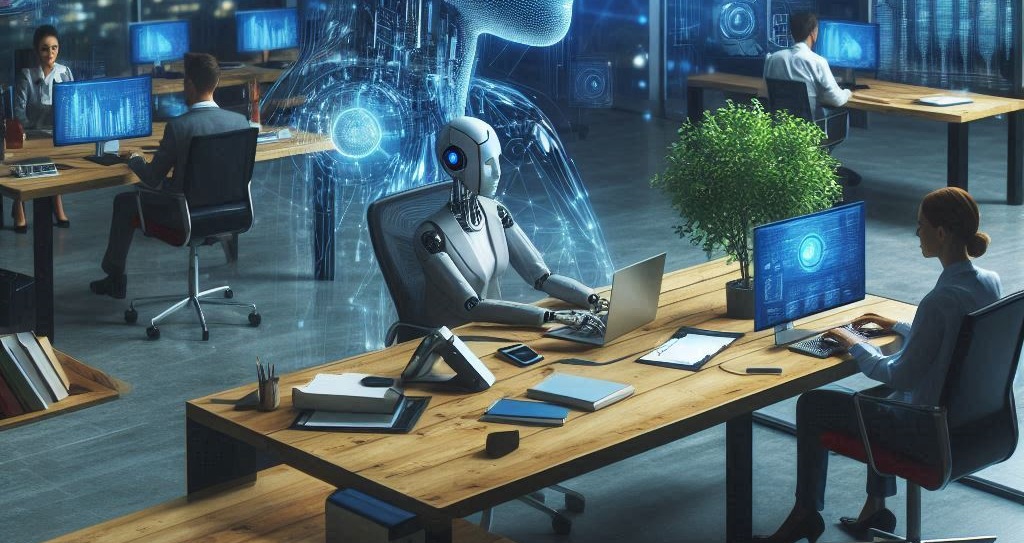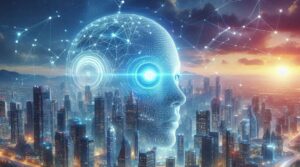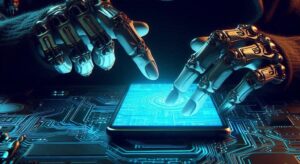Artificial Intelligence (AI) has rapidly transformed from a futuristic concept into a tangible reality, deeply integrated into various aspects of modern workplaces. As AI technologies continue to advance, their impact on how we work, collaborate, and manage tasks has become increasingly profound.
From automating routine tasks to enhancing decision-making processes, AI is reshaping the workplace in ways that were once unimaginable. This article explores the multifaceted impact of AI on modern workplaces, highlighting the opportunities, challenges, and future implications of this technological revolution.
Read More: The Ultimate Guide to Email Marketing: Strategies, Best Practices, and Tips for Success
1. Automation of Routine Tasks
One of the most significant impacts of AI in the workplace is the automation of routine tasks. AI-powered tools and systems can efficiently handle repetitive and time-consuming activities, allowing employees to focus on more strategic and creative aspects of their jobs.
For instance, AI-driven chatbots are now widely used in customer service departments to handle common inquiries, freeing up human agents to address more complex issues. Similarly, AI algorithms can automate data entry, invoice processing, and other administrative tasks, reducing the burden on employees and increasing overall productivity.
However, the automation of routine tasks also raises concerns about job displacement. As AI takes over tasks traditionally performed by humans, there is a growing fear that certain jobs may become obsolete.
While it is true that AI can replace some roles, it is equally important to recognize that AI can also create new opportunities. The key lies in reskilling and upskilling the workforce to adapt to the changing demands of the AI-driven workplace.
2. Enhanced Decision-Making
AI’s ability to analyze vast amounts of data in real-time has revolutionized decision-making processes in modern workplaces. AI-powered analytics tools can sift through data to identify patterns, trends, and insights that would be difficult for humans to detect. This capability allows organizations to make more informed and data-driven decisions, ultimately leading to better outcomes.
For example, in the financial sector, AI algorithms are used to analyze market trends and predict investment opportunities, enabling traders and investors to make more accurate decisions. In healthcare, AI-powered diagnostic tools assist doctors in making precise diagnoses by analyzing medical images and patient data. These examples demonstrate how AI enhances decision-making across various industries, leading to improved efficiency and effectiveness.
However, relying heavily on AI for decision-making also comes with challenges. AI systems are only as good as the data they are trained on, and biased or incomplete data can lead to flawed decisions. Additionally, there is a risk of over-reliance on AI, where human judgment is overshadowed by machine recommendations. To mitigate these risks, it is crucial to maintain a balance between AI-driven insights and human intuition.
3. Improved Employee Experience
AI has the potential to significantly improve the employee experience by personalizing work environments and streamlining tasks. AI-driven platforms can analyze individual work patterns and preferences to create tailored work schedules, recommend learning and development opportunities, and even suggest wellness activities to reduce stress and burnout. This level of personalization can lead to increased job satisfaction, productivity, and overall well-being.
Moreover, AI-powered tools can enhance communication and collaboration within teams. For instance, AI-driven project management platforms can automate task assignments, track progress, and send reminders, ensuring that projects stay on track. Additionally, AI can facilitate virtual collaboration by providing real-time language translation and transcription services, breaking down communication barriers in global teams.
Despite these benefits, there are concerns about privacy and surveillance in AI-enhanced workplaces. The use of AI to monitor employee performance and behavior can create a sense of constant surveillance, leading to discomfort and mistrust among employees. Organizations must strike a balance between leveraging AI to improve the employee experience and respecting employees’ privacy and autonomy.
4. Transformation of Human Resources
AI is also transforming human resources (HR) functions, from recruitment and talent management to employee engagement and retention. AI-powered recruitment tools can analyze resumes, conduct initial interviews, and assess candidates’ suitability for a role, significantly speeding up the hiring process. These tools can also help eliminate unconscious bias in recruitment by focusing on objective criteria rather than subjective judgments.
In talent management, AI-driven platforms can analyze employee performance data to identify high-potential employees and recommend personalized development plans. AI can also predict employee turnover by analyzing factors such as job satisfaction, engagement levels, and career progression, allowing organizations to take proactive measures to retain top talent.
However, the use of AI in HR also raises ethical concerns. The potential for bias in AI algorithms, the lack of transparency in decision-making processes, and the risk of dehumanizing HR functions are significant challenges that organizations must address. To ensure ethical AI use in HR, organizations should prioritize transparency, accountability, and fairness in their AI-driven HR practices.
5. Reshaping Workplace Culture
The integration of AI into modern workplaces is also reshaping workplace culture. As AI takes over routine tasks and enhances decision-making, employees are increasingly required to focus on more complex, creative, and strategic activities. This shift is leading to a culture that values innovation, continuous learning, and adaptability.
AI is also driving a move towards more flexible and remote work arrangements. AI-powered tools enable seamless remote collaboration, allowing employees to work from anywhere while staying connected to their teams. This flexibility is changing the traditional 9-to-5 work culture, leading to a more results-oriented approach where performance is measured by outcomes rather than hours spent in the office.
However, the rapid pace of AI-driven change can also lead to resistance and fear among employees. To foster a positive workplace culture, organizations must prioritize communication, transparency, and employee involvement in AI initiatives. By involving employees in the AI adoption process and providing them with the necessary training and support, organizations can create a culture of trust and collaboration.
6. The Future of AI in Workplaces
As AI continues to evolve, its impact on modern workplaces will only deepen. The future of AI in the workplace is likely to involve even more advanced automation, enhanced decision-making capabilities, and personalized employee experiences. However, this future also presents challenges, particularly in terms of ethics, privacy, and the potential for job displacement.
To navigate these challenges, organizations must adopt a balanced approach to AI integration. This approach should prioritize the well-being of employees, ethical AI use, and continuous learning and development. By doing so, organizations can harness the full potential of AI while mitigating its risks, ultimately creating a workplace that is not only more efficient but also more human-centric.
Conclusion
The impact of AI on modern workplaces is profound and far-reaching. From automating routine tasks to enhancing decision-making, improving the employee experience, transforming HR functions, reshaping workplace culture, and shaping the future of work, AI is revolutionizing how we work.
While the opportunities presented by AI are immense, it is crucial to address the challenges and ethical considerations that come with its integration. By adopting a thoughtful and balanced approach to AI, organizations can create a future of work that is both innovative and inclusive.








